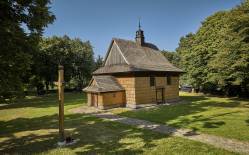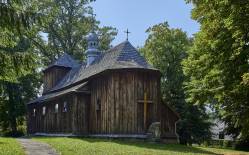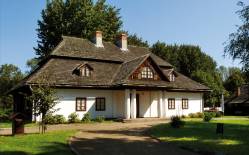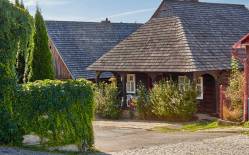The history of the Hunting Lodge in Julin goes back to 1872 when Roman Potocki, owner of the Łańcut estate, initiated the construction of the palace in the “spa-resort style” (referring to Swiss-Tyrol style of architecture).
The establishment comprised the palace, pavilion and gateway building, located within a 9-hectare park, which could be entered via a larch avenue; the latter can still be seen here today. The complex was expanded in 1890 when director’s office, ice-house and kitchen facility were added. Subsequently barn and stable were built, and later a brick gatehouse was added; the latter provided lodgings for the doorman and, seasonally, for the gardener.
The palace was built from larch wood. Its outer walls are not covered by planks, except for the corners. The building has a T-shaped layout. Partly a two-story structure, it also comprises single-story segments on the northern and southern side. It is covered with a few double-pitched roofs embellished with decorative chimneys and a small tower with a gallery.
The place has retained its architectural features. Inside we can admire intricately carved wooden framings of windows and doors, wall panelling, ornamented ceilings, stoves, fireplaces, library cabinets and wrought iron railings.
During the First World War the palace was transformed into an Austro-Hungarian field hospital. As a result of the warfare the establishment was significantly damaged and its renovation after the war required significant expenditures.
A flower garden was created in the park along with a golf course.
In 1944 the most valuable furnishings of the palace were moved to Łańcut. Currently the palace is administered by the Castle Museum in Łańcut.
The establishment is located in an area which in the past was covered by the Sandomierz Primeval Forests. In the vicinity there is Wydrze Nature Reserve which protects stands of Polish larch.
Photo: Karolina Kiwior
Gallery
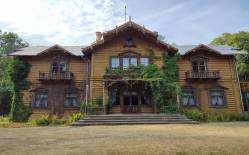
Recommended venues on the Trail



This website has been modernized with the financial support of the European Union under the Cross-Border Cooperation Programme Poland-Belarus-Ukraine 2014-2020. The responsibility for its content lies solely with the Podkarpackie Regional Tourism Board and cannot, in any case, be treated as a reflection of the position of the European Union, the Managing Authority, or the Joint Technical Secretariat of the Cross-Border Cooperation Programme Poland-Belarus-Ukraine 2014-2020.










